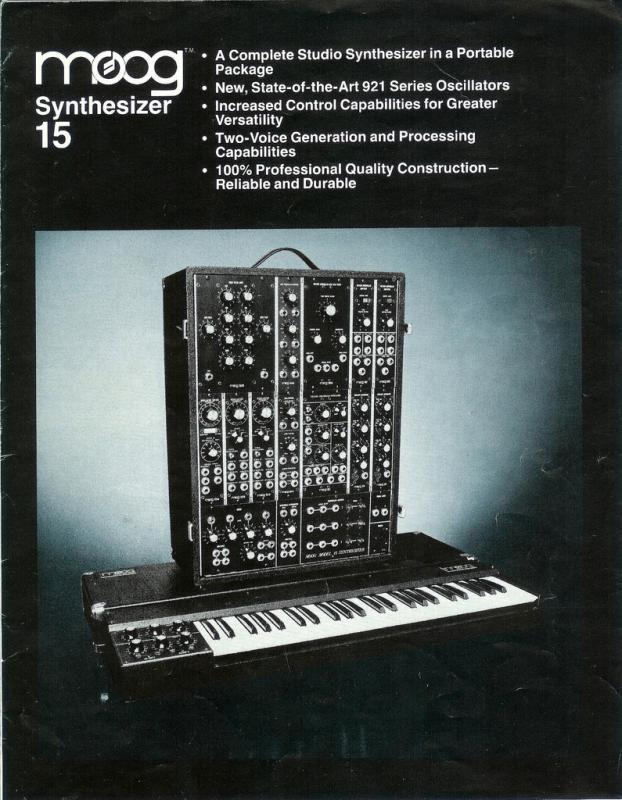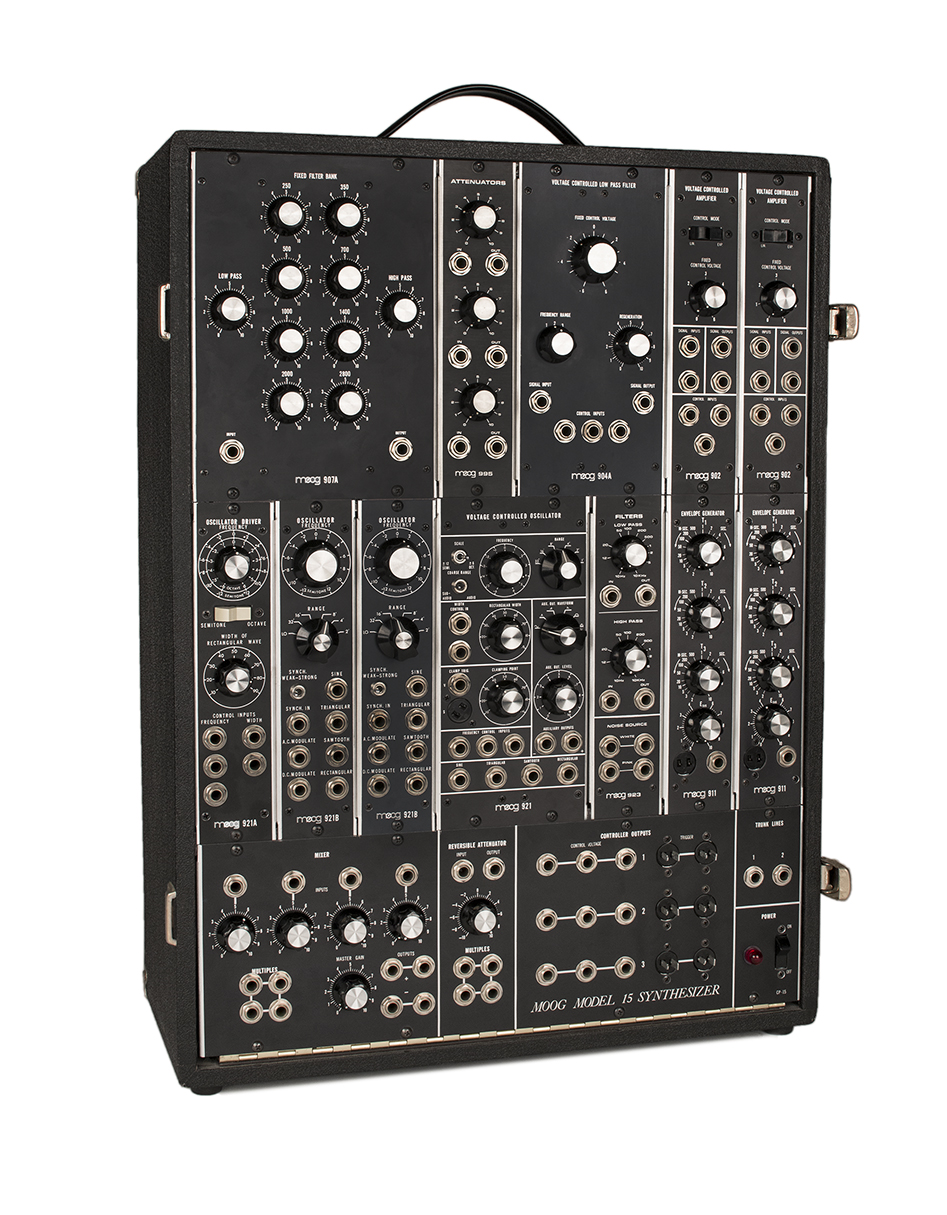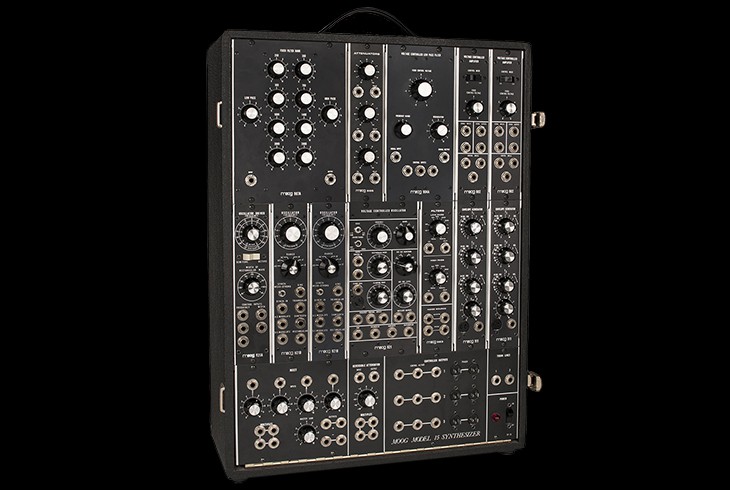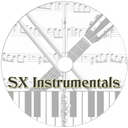Filter on ALL, SYNTH, DRUM, SAMPLER or MISC |
Total list currently 2405 items in 330 Brands |
Moog | Model 15 |
Description | Faithfully Recreating The Model 15 Three years of research and design has culminated in Moog Music recommencing the manufacturing of a limited number of Moog Model 15 modular synthesizers. Using all of the original documentation, as well as the original circuit board and art files, Moog engineers have hand-built true recreations of the original instruments based on their 1973 factory specifications. Each individual module is hand-stuffed and the components are hand-soldered to circuit boards using traditional wiring methods. Each module is then finished with a photo-etched aluminum panel, and placed in its new modular instrument. This limited reissue of the Moog Model 15 modular synthesizer is built to order. Only 150 total units will be made and sold worldwide. Model 15 Modules 2x 902 Voltage Controlled Amplifiers 1x 904A Voltage Controlled Low Pass Filter 1x 907A Fixed Filter Bank 2x 911 Envelope Generators 1x 921 Voltage Controlled Oscillator 1x 921A Oscillator driver 2x 921B Oscillators 1x 923 Random Noise/Filter 1x 995 Attenuator 1x CP15 Console Panel 1x 130 Watt 120 VAC Power Supply(230 VAC available upon request) Model 15 The Moog modular Model 15 is an ultra-powerful, compact studio synthesizer designed for live performance and portability. It is housed in a rugged tolex-encased cabinet and is an ideal solution for the touring synthesist. The Model 15 design focuses on speed, creativity and simplicity while still providing the enormous sonic depth and dimension found only in a vintage Moog modular synthesizer. Faithfully Recreating The Model 15 Over the course of 3 years Moog Music set out to research and build a faithful recreation of the classic Moog modular Model 15 analog synthesizer. Using all original documentation as well as circuit board and art files for every module, Moog Engineers have painstakingly recreated this powerful and portable analog system. Each Model 15 is hand-built to its original 1974 Moog factory specifications and is a true recreation of the original. Individual modules are brought to life just as the originals were, by hand-stuffing and hand-soldering components to circuit boards, and using traditional wiring methods. Each module is then finished with a photo-etched aluminum panel, and placed in its new modular instrument. This limited edition reissue of the Moog modular Model 15 is built to order, and is available in very limited quantities. Only 150 Model 15s will be made. Model 15 Modules 2x 902 Voltage Controlled Amplifiers 1x 904A Voltage Controlled Low Pass Filter 1x 907A Fixed Filter Bank 2x 911 Envelope Generators 1x 921 Voltage Controlled Oscillator 1x 921A Oscillator driver 2x 921B Oscillators 1x 923 Random Noise/Filter 1x 995 Attenuator 1x CP15 Console Panel 1x 130 Watt 120 VAC Power Supply(230 VAC available upon request) Included Cabling 10x - 1' 1/4" TS cables 8x - 2' 1/4" TS cables 2x - 1' S-Trigger cables 1x - 1.5' S-Trigger cable 1x - 'Y-cable'S-Trigger Weight and Dimensions Main Cabinet Weight: 50 lbs. Dimension: 18” wide x 25” high x 9 ½” deep Modules And Their Original “Functional Descriptions”. 902 Voltage Controlled Amplifiers: The 902 voltage Controlled Amplifier is a differential input and output circuit which gives an overall voltage gain of 2 {6dB} when the manual control potentiometer is at maximum {6}, or when a control voltage of 6 volts is applied to the control input. Maximum sum of control voltage {fixed control voltage and input jacks} is approximately 7.5 control volts, producing +4.7dB or gain of 3. Two modes of gain response are available: linear and exponential. 904A Voltage Controlled Low Pass Filter: The 904A Low Pass Filter attenuates frequencies above the fixed control voltage cutoff point at a rate of 24dB per octave. The cutoff point {cutoff frequency} is voltage controlled through the control input jacks. The sum of the applied control voltages doubles the frequency of the cutoff point for each one-volt increase {volt per octave standardization}. The regeneration potentiometer {variable Q} varies the amount of internal feedback, creating a resonant peak at the cutoff frequency. This resonant peak will break into oscillation at clockwise settings of the regeneration pot, creating a voltage controlled sine wave generator. The fixed control voltage pot covers a 12-volt {octave} range. The overall range of the FCV pot is determined by the Frequency Range switch, which moves the frequency cutoff range in two-octave steps. The basic cutoff frequency of the Low Pass Filter is determined by the combination of fixed control voltage and frequency range in addition to the control input signals. An increase in regeneration narrows and increases the strength of the cutoff frequency peak, while decreasing the amplitude of the lower frequencies. 907A Fixed Filter Bank: The 907A Fixed Filter Bank is a non-voltage controlled modifier, which emphasizes or reduces the gain of the center frequency bands indicated on each of the eight center pots, in addition to the cutoff points set by low pass and high pass filters at either frequency extreme. A total of 10 overlapping LC networks are included. 911 Envelope Generators: At the introduction of a switch-to-ground {S-trigger} trigger signal from an external source, the 911 Envelope Generator produces a single voltage contour whose time/voltage variation is determined by potentiometers T1, T2, T3 and a time constant sustaining level pot {Esus}. Closure of the input trigger switch directs the voltage contour to T3 {final decay} regardless of what stage { T1, T2 or E} was in current operation. The Envelope Generator requires an S-trigger to operate. External sources must be converted to the S-trigger format. 921 Voltage Controlled Oscillator: The 921 Voltage Controlled Oscillator is a variable waveform generator, which produces frequencies ranging from .01Hz to 40kHz. Four waveforms are available: Sine, Triangular, Sawtooth, and Rectangular {with variable duty cycle}. Both fixed and variable levels can be obtained from front panel output jacks. Nominal frequency is set manually by the scale, coarse range, frequency and {octave} range controls found at the top of the module. Voltage controlled rectangular width is set by the knob in the upper center {left}, with accompanying voltage input jacks. Clamping point {waveform reset control} may be set with the lower left knob and accompanying trigger inputs to the left. Multiple frequency control inputs can be plugged into this module in parallel. All waveform outputs can be used concurrently if desired. All manual controls on this module can be moved or switched during operation. This module functions as both an audio or control voltage generator. 921A Oscillator driver: The 921A Oscillator Driver is a control voltage processor, which drives associated 921B oscillators through internally wired connections {via edge connectors}. Two voltages are generated: one for frequency control and one for rectangular wave duty cycle. Control inputs to this module change the frequency of its associated oscillators in volt/octave increments. Manual adjustment to the Frequency and Width Of Rectangular Wave pots changes the nominal frequency and duty cycle of all connected 921B's in parallel. Two ranges are provided on the Frequency potentiometer: semitone {two octaves compass} and octave {12 octaves compass} These ranges are selected by the white switch below the Frequency potentiometer. Control inputs for frequency and rectangular width are summing. 921B Oscillators: The 921B Oscillator generates frequencies from 1Hz to 40kHz minimum. They are wired in groups to a common 921A Oscillator Driver, which provides both exponential frequency control and rectangular width voltage control. Like the 921 Oscillator, this is one of the building blocks of analog synthesis. This oscillator generates both sub-audio and audio frequencies for control and audio signal use. The Frequency pot at the top of the module has a two-octave range for fine-tuning, while the Range switch shifts the frequency of the oscillator in octaves, up or down. Number indications on the Range switch correspond to traditional organ pipe range notations. Fixed level outputs for Sine, Triangle, Sawtooth and Rectangular waveforms are found at the right of the modules. DC Modulate is a linear frequency control input {does not conform to 1 volt/octave control voltage format}. AC Modulate input is a capacitor-coupled circuit like the DC Modulate input, however, blocking constant DC voltages. 921B Oscillators may be phase locked together via the Synch input jack and the associated three position Synch Switch. Phase locking capability is generally limited to the first six harmonics of the input signal. A sawtooth waveform is recommended for best synchronization results. 923 Random Noise/Filter:The White and Pink noise outputs of the 923 Random Noise/Filter module produces continuous bursts of random frequencies and waveshape throughout the audio spectrum. Pink noise displays equal amplitude/energy per octave. A resultant lower frequency concentration for Pink Noise marks the difference between the two outputs, with white noise appearing in even intensity throughout the audio spectrum. Parallel outputs are provided for both noise sources. The two manual sweep filters, Low Pass and High Pass, are single pole {RC} circuits with a frequency cutoff slope of 6dB per octave. 995 Attenuator: Attenuators reduce the gain or amplitude of any applied input signal, control or audio. Moving clockwise from zero gain to unity with input, these attenuators can be used for reducing the effect of a control upon a voltage controlled module, providing up to three variable outputs from a single source input or reducing the gain of an entire signal complex. The Moog 953 is a 61 key duophonic keyboard designed for use with the Moog modular System 55, 35 and Model 15 analog synthesizers, as well as for use with vintage Moog modular synthesizers. |
| Brand | Moog |
| Model | Model 15 |
| Device | Synth |
| Type | Desktop |
| Engine Type | Analog |
| Engine | Modular |
| Voices (max) | 1 |
| Oscillators | 1 |
| Noise | Y |
| Engine Detailed | 1 VCO, Pink Noise, Saw Down, Saw Up, Sine, Square, Triangle, White Noise |
| Filter (VCF) | 1 24dB Slope (4-pole), Low Pass, Resonance |
| Envelope (VCA) | 2 ADSR |
| Keys | 61 |
| Key type | Keys |
| Velocity | N |
| Aftertouch | N |
| CV-gate | CV/GATE, S-trigger use |
| Extra info | Only 150 made |
| Produced: | 2016 - 2016 |
| Legend: | Obvious | Y: Yes, N: No, N/A: Not Applicable | |
| VCO | Voltage Controlled Oscillator | DCO | Digital Controlled Oscillator |
| LFO | Low Frequency Oscillator | Sub | Sub Oscillator |
| VCF | Voltage Controlled Filter | VCA | Voltage Controlled Amplifier |
| Velocity | As with a piano, the harder you hit a key, the louder the sound, unlike most organs which always produce the same loudness no matter how hard you hit a key. | Aftertouch | Pressing a key after you activated it. Channel Aftertouch, no matter which key, it will send a Channel message. Poly Aftertouch, sends the pressure per key instead of the whole channel. |
| Values for OSC, LFO, Filter, Envelope are per voice unless stated otherwise. | |||





